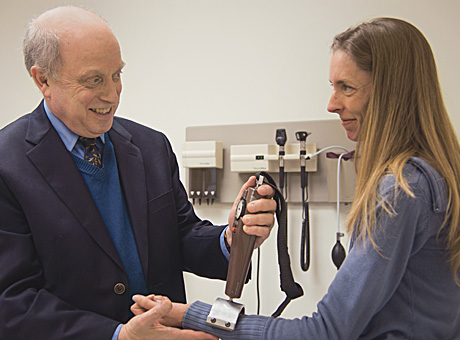
Alan Pestronk, MD, director of the Neuromuscular Division, with patient Gretchen Miller in the neurology clinic.

Alan Pestronk, MD, director of the Neuromuscular Division, with patient Gretchen Miller in the neurology clinic.
Diseases of the muscles and nerves range from the uncommon to the very familiar. Common symptoms include weakness and sensations of numb or tingling hands and feet.
In just the last several years, researchers at Washington University have discovered new genetic forms of neuromuscular diseases — a variant form of amyotrophic lateral sclerosis (ALS), commonly known as Lou Gehrig’s disease, and disorders that cause muscle and nerve damage.
These discoveries point to a nationally recognized strength of the School of Medicine’s neuromuscular program. “We have the combined strength of one of the busiest clinical programs for the care of patients and a large neuromuscular physician research group,” says Alan Pestronk, MD, director of the Neuromuscular Division.
Researchers in the division explore the genetic and autoimmune causes of often devastating diseases that strike nerves or muscles, such as ALS, muscular dystrophy, myositis, and immune and hereditary nerve disorders. Because many of these diseases are uncommon, researchers have created a DNA bank, a collection for use in ongoing studies that includes genetic information from thousands of patients.
“Just by looking at muscle through the microscope, we can tell the kinds of myopathies patients are likely to develop and which treatments are likely to be effective.”
— ALAN PESTRONK, MD
Focused efforts on the genetic causes of ALS point to single mutated genes that produce a toxic protein. “We now are testing a chemical compound that blocks the production of one such toxic protein in human patients,” says Pestronk. “The studies are generating hope that we can treat some forms of ALS, which currently have no cure.”
Researchers also have identified a serum antibody that may point to the cause of some previously unexplained, painful neuropathies, opening the door to the development of new drug therapies.
More than a decade of research into the autoimmune causes of chronic muscle inflammation and weakness has led to the creation of an exciting and specific muscle biopsy diagnostic process. “Just by looking at muscle through the microscope, we can tell the kinds of myopathies patients are likely to develop and which treatments are likely to be effective,” Pestronk says.
More funding would enable the division to accelerate efforts to identify the genetic and immune triggers for neuromuscular diseases.
“In many diseases that we treat,” says Pestronk, “we are getting better ideas of the molecular mechanisms that cause them, which means effective treatments are closer to reality.”